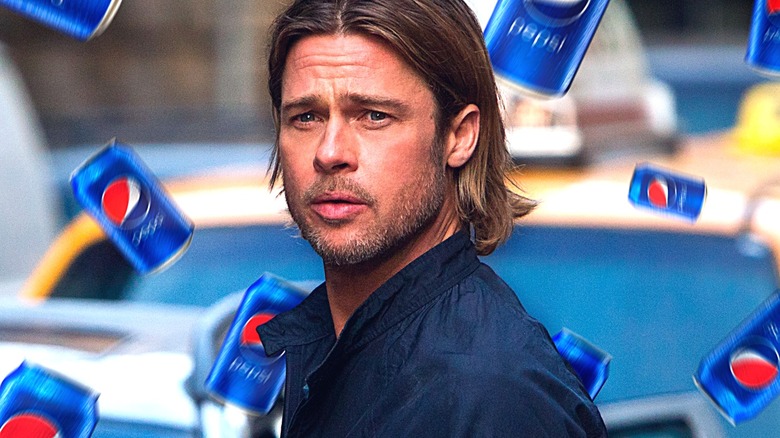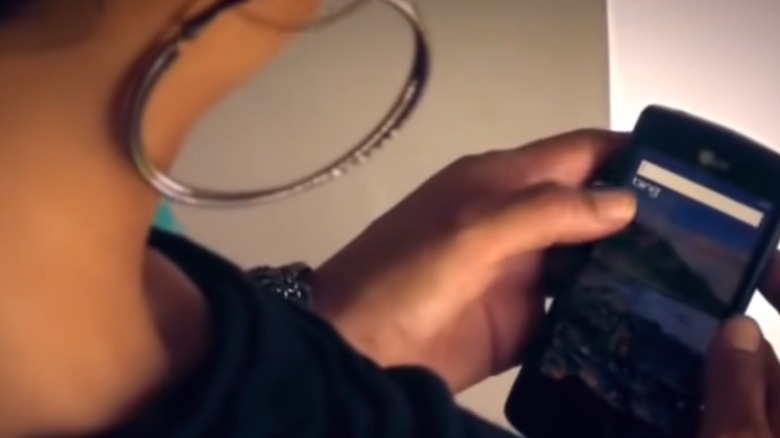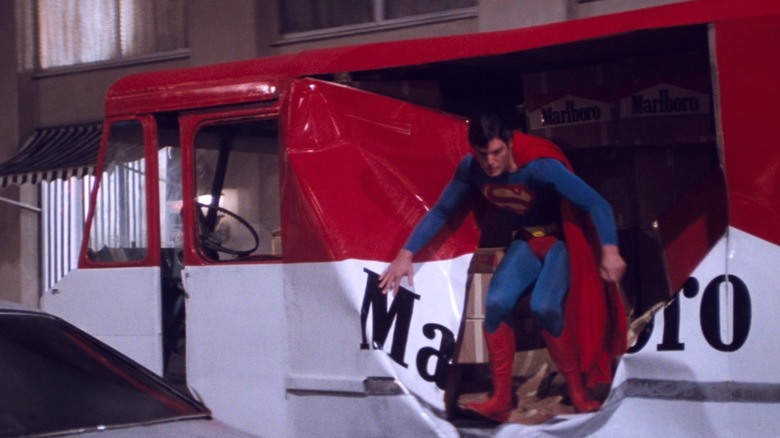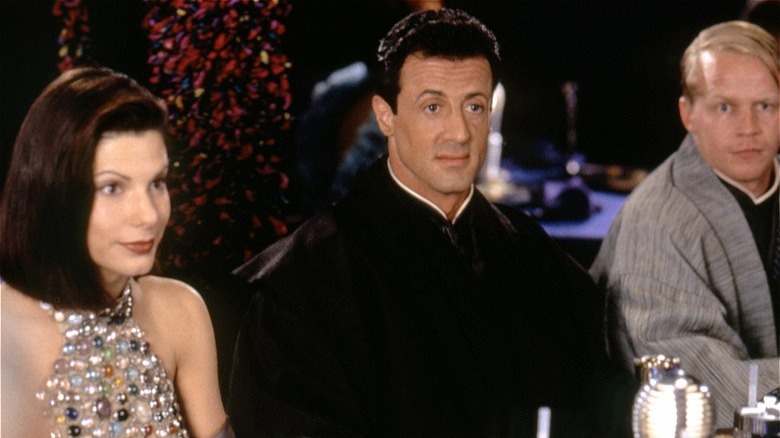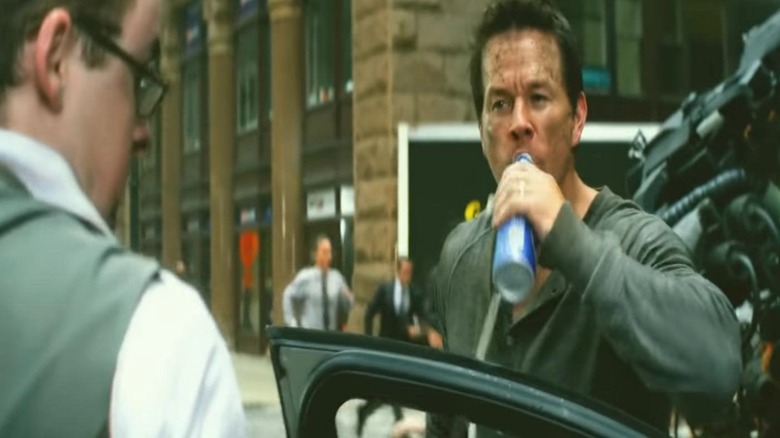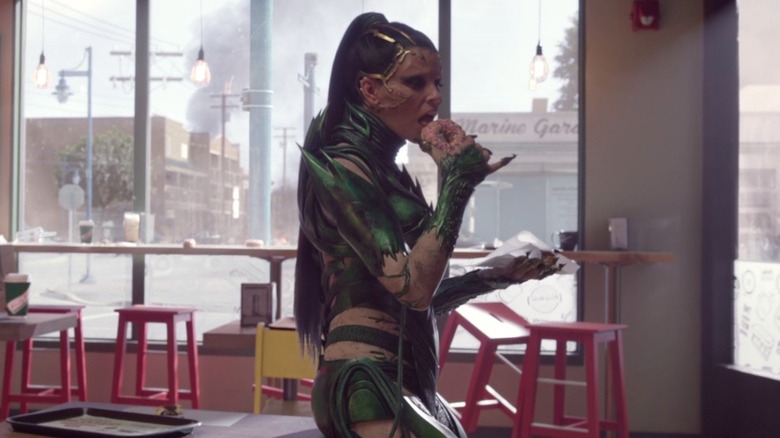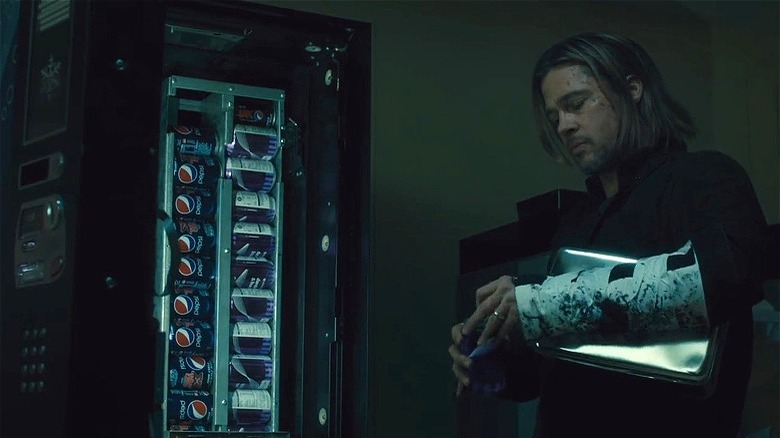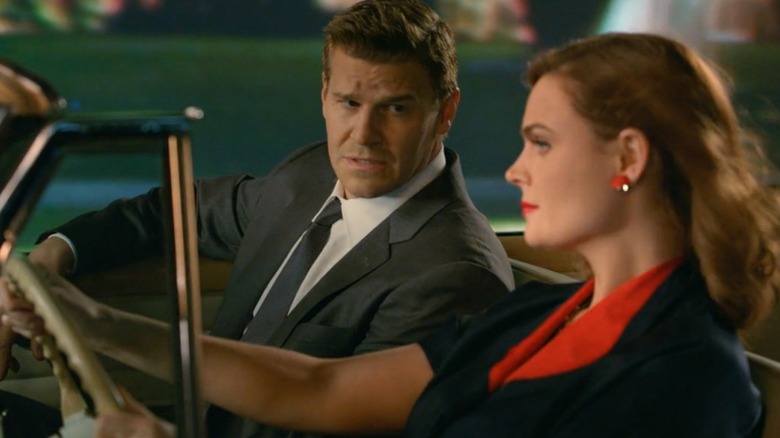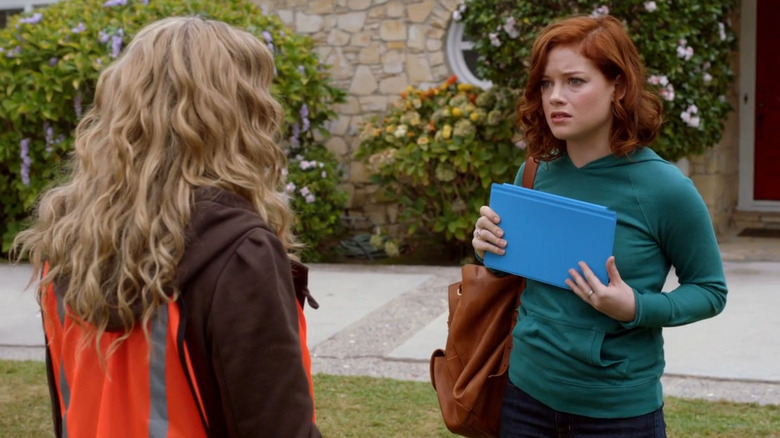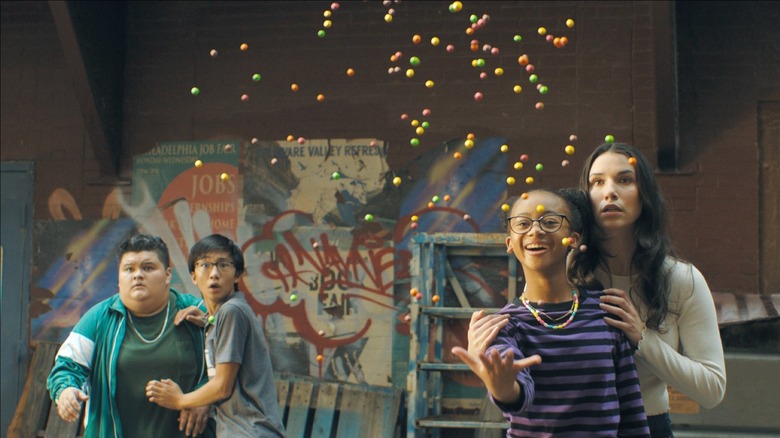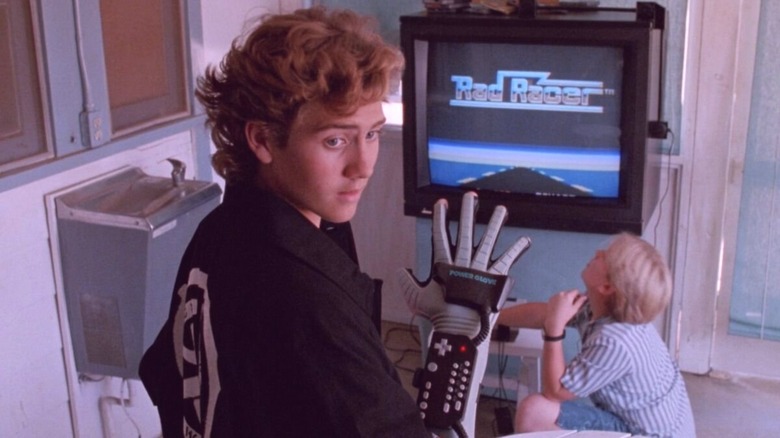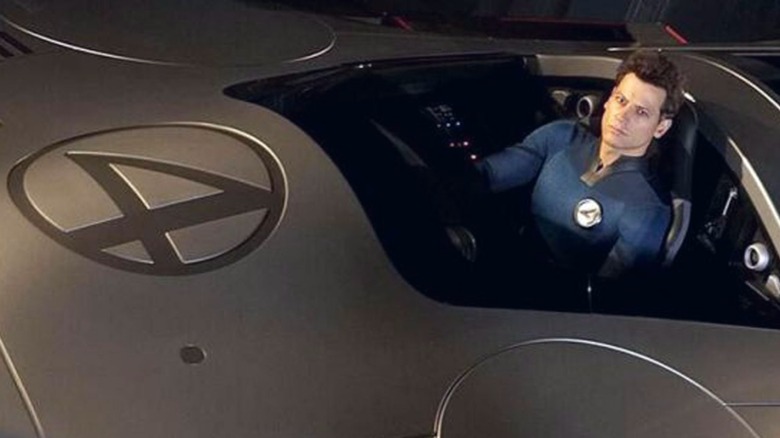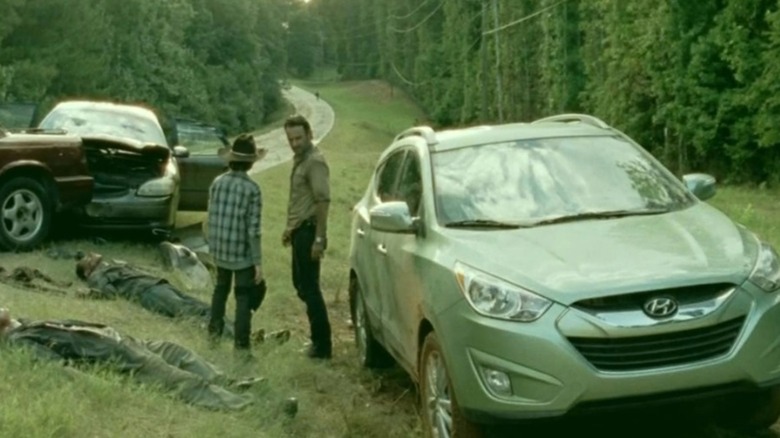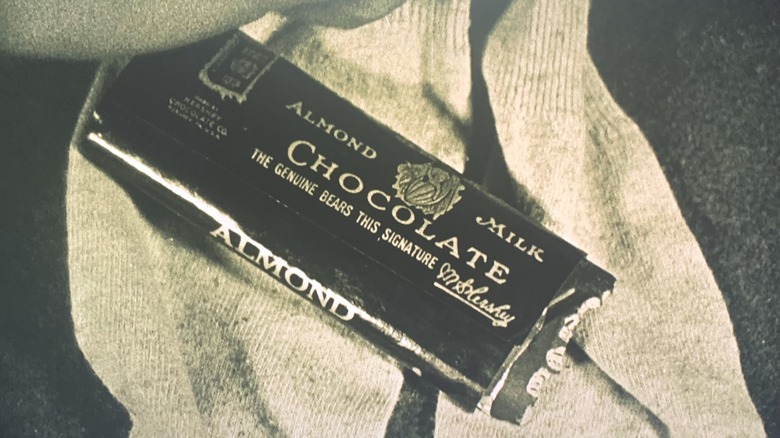Awful Product Placements That Ruined Great Scenes
Product placements are an interesting aspect of filmmaking and television. On the one hand, it's one of the ways the studios generate revenue, so it makes sense from a financial perspective. On the other hand, it helps make a scene seem natural if the characters and locations are relevant to our own lives — if someone sips from a coffee cup in the U.S., odds are that it will have a Starbucks label.
Still, there are product placements in movies and television that do the opposite — seeing them takes the viewer out of the experience, often ruining the scene. This happens relatively often, and while movies like "Wayne's World 2" poke fun at the practice, most attempt to keep their product placement on the edge. Putting something in the scene without making it a distraction is essential, but filmmakers don't get it right every time.
Every so often, however, a scene involves a product placement that's too obvious. This can happen when the episode or movie's flow is utterly interrupted, removing the audience from the narrative. Some instances are worse than others, but they all stand out, and each of these scenes involves a product placement that had the opposite intended effect.
Hawaii Five-O couldn't get people to Bing it!
In the 1990s, numerous search engines vied for power as the Internet expanded into what it is today. There were many, including Ask Jeeves, AltaVista, and more. Google arrived in 1998, and it didn't take long for the simple search engine to dominate the competition such that many people now use the word "Google" as a term for searching online.
Google isn't the only search engine out there, but it has a significant chunk of the market. Microsoft eyed that market with the development of Bing, but it struggled to find relevance. Enter a massive product placement campaign that sought to inject Bing into everyone's lives. In many instances, it was a minor thing, but one episode of "Hawaii Five-O" took things a bit too far.
Microsoft wanted people to use the term "Bing it" as a replacement for the far more ubiquitous "Google it," and it didn't catch on. In the episode, Chin (Daniel Dae Kim) and Kono (Grace Park) disagree about a piece of art; Chin suggests she "Bing it," so she pulls out her Windows Phone 7 and ... Bings it. It's a weird thing to say in the moment, and it upsets the flow, ruining the scene.
Superman II's fight scene on the streets of Metropolis
"Superman II" expanded on the Man of Steel's feature film debut by pitting him against General Zod and his minions. This gave Superman a proper fight with enemies he had to work hard at defeating, culminating in a massive brouhaha on the streets of Metropolis. Superman and the others fly through various obstacles during the fight, including a Coca-Cola billboard and a truck.
The truck features the Marlboro logo prominently on its side, and Superman crashes into it. The truck takes up a lot of screen time, which makes sense when you learn that Philip Morris International paid $40,000 to feature it, even though cigarette companies don't place logos on their trucks to prevent highway hijackings. Still, the main problem with the truck is that it's prominently displayed in a superhero movie marketed toward children.
Anti-smoking advocates had a field day with "Superman II," which mentions Marlboro cigarettes 20 times throughout the film. The truck was merely the icing on the cake, and things heated up so much that Congress held a hearing focused on cigarette advertisements and children, resulting in legislation restricting similar product placements in the future.
Demolition Man's Taco Bell scene raised too many questions
"Demolition Man" is one of those movies that leaves the audience with some unanswered questions. Just ask any fan about the three seashells, for example, and you'll open a can of worms. That's a funny aspect of the film, but one of the most distracting scenes takes place at Taco Bell — and as Lenina Huxley (Sandra Bullock) puts it, "All restaurants are Taco Bell."
What follows is a fish-out-of-water dinner consisting of John Spartan (Sylvester Stallone) wined and dined by the upper echelons of 2032 San Angeles' elite. It's difficult to focus on what happens in the scene because the viewer is left wondering about the so-called "restaurant wars," how Taco Bell came out on top, and why every restaurant is somehow a Taco Bell.
Of course, it's all marketing, and Taco Bell paid good money to win the restaurant wars for "Demolition Man." Outside the U.S., Pizza Hut replaced Taco Bell since there weren't many Taco Bells outside the country in 1993. Taco Bell opened a gourmet pop-up restaurant in San Diego to celebrate the film's 25th anniversary, so while the scene is distracting in the movie, it's hard to argue that the marketing didn't work.
The Bud Light crash scene in Transformers: Age of Extinction
"Transformers: Age of Extinction" is the fourth film in director Michael Bay's massive franchise and the first to feature Mark Wahlberg as its lead. Like its predecessors, "Age of Extinction" is filled to the brim with product placements, giant robot battles, and inappropriate sexual innuendoes, while also cementing itself in franchise history as the second "Transformers" movie to cross the $1 billion mark at the global box office.
The "Transformers" franchise has always been about product placement, as the '80s cartoon's primary purpose was selling toys. It's no different in live-action, with many cars from brands like Chevrolet and Lamborghini gracing the screen. Product placement runs rampant throughout "Age of Extinction," and while there are plenty of examples, the most intrusive instance deals with Bud Light.
Cade Yeager (Wahlberg) is nearly killed when the burning wreckage of his spaceship flies down the street. It slams into a Bud Light truck, scattering bottles and cans all over the street. When a driver whose car he hit angrily confronts him over the damage, he gets upset, grabs a Bud Light, and takes a mean swig before threatening the guy. Like anyone would do.
Power Rangers' climax overdid it with Krispy Kreme
It's not uncommon for a movie to feature products from a myriad of companies, so it's not unusual to see a variety of product placements in a film. What's weird is when a movie features a single company in far greater detail than any other. It's why "Superman II" ran into trouble with its cigarette messaging, and it's why "Power Rangers" found its way here, though instead of smokes, it's all about Krispy Kreme donuts.
There are far too many Krispy Kreme appearances in the movie, so much that Mashable called it the "Sixth Ranger in the new 'Power Rangers' film." The film features a training scene inside Krispy Kreme, while another store is the location of the Zeo Crystal. It's also the secret location of one Rita Repulsa (Elizabeth Banks), the film's villain.
That comes around at the movie's end because, during the final fight, Repulsa stops at her local Krispy Kreme, sits back, and enjoys a donut before being interrupted by a touch of light destruction. It's such an unusual scene that the audience couldn't help but notice they were watching a commercial for donuts at the end of the movie — it's that intrusive.
The Pepsi scene in World War Z is absolutely absurd
In "World War Z," Brad Pitt plays Gerry Lane, a former U.N. investigator intent on finding a cure for a zombie plague. As he travels from place to place, he learns more about the virus, ultimately leading him to a World Health Organization research facility in Cardiff, Wales. After realizing that the infected avoid anyone with a terminal condition, he injects himself with ... something.
It's the climactic scene near the end of the film, and it's intense. After walking by several zombies without being attacked, he heads to a vending machine. At this point, he needs to make a lot of noise to force the zombies to move, so he eyes the vending machine for this purpose. It's a Pepsi machine, which is weird enough, because Pepsi is the only drink inside — no other Pepsi products or anything else.
Lane doesn't mind and even takes a moment to stand there and enjoy a cool, refreshing beverage before triggering the rest of the cans to fall and make a lot of noise. It's understandable since he needs to get the zombies' attention, but the scene is ruined by the oddly-placed Pepsi commercial, as it's meant to be the most tense moment in the movie.
Nearly every driving scene in Bones
"Bones" centered around a working and eventual romantic relationship between FBI Agent Seeley Booth (David Boreanaz) and forensic anthropologist Temperance "Bones" Brennan (Emily Deschanel). The series ran for 12 seasons, and Toyota injected tons of cash into the production through most of its run. You'll see Toyota's vehicles in many scenes, but the worst product placements involve driving.
Whenever Brennan and Booth have to get somewhere, they often drive together. This allowed Toyota to show off its latest products, and "Bones" did not disappoint the car company. In nearly every driving scene, the narrative is interrupted as the characters admire various automotive features of whatever they're driving, and it's hard not to see anything but a car commercial during these sequences.
The scenes are typically one minute long, but they're so blatant that it seems the producers and Toyota wanted to make them as glaringly egregious as possible. On the one hand, the Toyota plugs within "Bones" are funny after a while. Still, they create a sense that the show sold out to the car company, which manages to upend whatever is happening in the episode as the narrative flow is interrupted by a car commercial.
Suburgatory features a commercial for Microsoft Surface
Microsoft unleashed a plethora of product placements promoting Windows 8 and related products in 2012. Many television shows featured characters handling a Microsoft Surface and its operating system, and while it' was noticeable, it didn't typically ruin a scene. Then there's "Suburgatory," which didn't simply add a Surface to a scene; the show effectively transformed into an ad.
The ad pops up mid-episode as Tessa Altman (Jane Levy) narrates, explaining how important her new tablet is in her life after falling out with her best friend. "My tablet and I — we're still in the honeymoon stage," she says. "And let me tell you, the two of us were made for each other. My tablet made me laugh! Made me cry. And the two of us, we didn't play games with each other unless you count 'Frogger.'"
At the end, she pulls out her tablet, telling Lisa (Allie Grant), "I'm starting my own relationship," before explaining that it's a "really personal tablet with a full-size USB port and an integrated kickstand. And a really sizeable hard drive." The tablet is Tessa's better half, and wouldn't you know, it's a Microsoft Surface! Ultimately, it's bizarre and more of a punchline than anything else.
The Teenage Mutant Ninja Turtles eat Domino's Pizza
"Teenage Mutant Ninja Turtles" was a massive hit when it came out as an animated series in 1987. It didn't take long for a live-action film to hit theaters, and for the most part, the 1990 release checked all the boxes. The turtles looked great, the story worked, and they showed off their love for pizza, which is a core aspect of their personalities.
There's even a scene where the turtles order a pizza, and it's funny because they are giant anthropomorphic teenage turtles ordering a pizza to a literal sewer grate. The turtles live in the tunnels beneath New York City, and while there's not much to eat down there, the city boasts some of the best pizza in the world. New Yorkers are proud of their pizza, so some of them probably died a little watching this scene.
There are countless pizza places the turtles could have ordered from, but they went with Domino's Pizza. There's nothing wrong with Domino's, but when you live under the city that inarguably hosts the best pizza in America, you don't order from Domino's. The scene is funny and works, but it's hard to watch knowing what else they could have enjoyed.
The Skittles scene in Shazam 2 is awkward
"Shazam! Fury of the Gods" hit theaters in 2023, and while it didn't perform well, it delved into the character's mythos and introduced a smorgasbord of villains and CGI monsters. At the film's climax, Shazam and his family of superhero teens and tweens band together to fight one of them, Kalypso (Lucy Liu). She brings forth an army of Greek mythical creatures, including the deadliest of them all, unicorns.
The movie puts a dark spin on unicorns by making them into vicious beasts, which is contrary to most depictions of the fantastical animals. The only way for the heroes to win is to recruit the unicorns to Shazam's side, and the only way to do it is with a bag of Skittles. Back in 1982, Steven Spielberg partnered with Reese's Pieces for "E.T.: The Extra-Terrestrial," but "Fury of the Gods" failed where he succeeded because the use of Skittles in the scene is ridiculous.
To pacify the unicorn, Darla (Faithe Herman/Meagan Good) feeds one a bag of Skittles, stopping it in its tracks. She even whispers the brand's tagline, "Taste the rainbow," as the colorful candies fly into the air. The advertisement is so obvious, it's laughable, and it effectively ruins the scene by coming off as a parody of "E.T."
The Power Glove scene in The Wizard
"The Wizard" is both a feature film and an incredibly long commercial for Nintendo. You can't escape the fact that the film promotes every aspect of the Nintendo Entertainment System by showcasing its games and peripheral devices. It's also a fun kids' movie about a group of children who travel to California to compete in a video game tournament.
The kids find their way to Lucas Barton (Jackey Vinson), where he shows off his skills playing "Rad Racer" with the Power Glove. The Power Glove was a glove outfitted with everything a player needed to play games on the NES, and while it looked cool and was a novel idea, it didn't work very well and was a commercial failure.
Despite this, Lucas shows his proficiency in using the device that Nintendo was desperate to sell, so he excels at it. He keeps it in a briefcase and shows it off as if it were the Holy Grail. After he finishes playing with it, he says, "I love the Power Glove. It's so bad." People haven't stopped making fun of this scene since; it's a bit over-the-top and too on the nose, functioning as a commercial within the movie.
The Fantasticar's Hemi in Rise of the Silver Surfer is super cringe
The Fantastic Four is one of Marvel Comics' best superhero books, but it's had a tumultuous history of live-action movie adaptations. The first commercial release came in 2005, and while it didn't impress critics, it brought in tons of cash, ensuring a sequel would follow. The sequel, "Fantastic Four: Rise of the Silver Surfer," hit theaters in 2007 and made a decent sum as well.
In the sequel, Reed Richards (Ioan Gruffudd) and Susan Storm (Jessica Alba) try hard to get married, but their superhero schtick keeps getting in the way. The film centers around the Silver Surfer preparing Earth for the coming of Galactus, and Doctor Doom (Julian McMahon) returns to muck everything up. The Four find themselves in need of transportation, so Reed calls in a surprise he'd been working on: the Fantasticar.
The Fantasticar has been a part of the comics since 1962, so fans were happy to see it, but unfortunately its arrival came into focus as an advertisement for Dodge. It sported a Dodge logo, so Johnny Storm (Chris Evans) asks, "Hemi?", to which Reed responds, "Of course." The scene was a play on Dodge's commercials at the time, making it incredibly cringeworthy.
Hyundai is The Walking Dead's post-apocalyptic vehicle of choice
"The Walking Dead" is easily one of the most successful zombie franchises ever, and while the TV series lost its audience as it progressed, it helped spawn an ever-expanding universe. The show follows a group of survivors as they try to carve out an existence at the end of the world. The zombies are more of a MacGuffin than anything else, as they drive the plot, while other groups of survivors are the real enemies.
Throughout the series, the characters drive various cars they've found lying around after the collapse of society. In most scenes involving cars, the vehicle in question is a Hyundai, often in pristine condition. This is the zombie apocalypse, and years into it, not only does gasoline still work, but the cars everyone drives are beautiful new Hyundai models apparently released after the fall of humanity.
It takes the viewer out of the experience because the cars create questions about how they're running, why they look as if someone just drove them off the lot, and how they're maintained and washed without using vital resources. Understandably, Hyundai didn't want its cars featured as zombified, destroyed wrecks, but it kills any scene they're in.
The product placement in Wings is a scene-stealer
Every movie that features product placement owes some thanks to the silent era, when it began. The first film to use it was "The Garage," but it wasn't until 1927's "Wings" that product placement became mainstream. The silent film was the first to win the Academy Award for best picture, and the studio re-released it a year later with synchronized sound.
"Wings" is about a romantic rivalry between World War I pilots, set around the Battle of Saint-Mihiel. While "Wings" holds many distinctions, it's remembered more today for its use of product placement than anything else. Several shots linger on Hershey's chocolate bars, and each time the camera does this, it steals the scene, distracting the viewer. This was especially true of the silent release of "Wings," but remained consistent when it became a "talkie."
In one glaringly obvious example, Cadet White (Gary Cooper) and David Armstrong (Richard Arlen) are in a tent when one grabs something to hand to the other. There's a bar of chocolate in the way, and it falls as the camera focuses on it. It stands out more than it should, making "Wings" the first best picture winner to use product placement — and the first movie to do so poorly.
